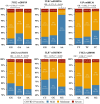Genetic variants regulating the immune response improve the prediction of COVID-19 severity provided by clinical variables
- PMID: 39237611
- PMCID: PMC11377536
- DOI: 10.1038/s41598-024-71476-2
Genetic variants regulating the immune response improve the prediction of COVID-19 severity provided by clinical variables
Abstract
The characteristics of the host are crucial in the final outcome of COVID-19. Herein, the influence of genetic and clinical variants in COVID-19 severity was investigated in a total of 1350 patients. Twenty-one single nucleotide polymorphisms of genes involved in SARS-CoV-2 sensing as Toll-like-Receptor 7, antiviral immunity as the type I interferon signalling pathway (TYK2, STAT1, STAT4, OAS1, SOCS) and the vasoactive intestinal peptide and its receptors (VIP/VIPR1,2) were studied. To analyse the association between polymorphisms and severity, a model adjusted by age, sex and different comorbidities was generated by ordinal logistic regression. The genotypes rs8108236-AA (OR 0.12 [95% CI 0.02-0.53]; p = 0.007) and rs280519-AG (OR 0.74 [95% CI 0.56-0.99]; p = 0.03) in TYK2, and rs688136-CC (OR 0.7 [95% CI 0.5-0.99]; p = 0.046) in VIP, were associated with lower severity; in contrast, rs3853839-GG in TLR7 (OR 1.44 [95% CI 1.07-1.94]; p = 0.016), rs280500-AG (OR 1.33 [95% CI 0.97-1.82]; p = 0.078) in TYK2 and rs1131454-AA in OAS1 (OR 1.29 [95% CI 0.95-1.75]; p = 0.110) were associated with higher severity. Therefore, these variants could influence the risk of severe COVID-19.
© 2024. The Author(s).
Conflict of interest statement
TFA-S has been consultant or investigator in clinical trials sponsored by the following pharmaceutical companies: Abbott, Alter, Aptatargets, Chemo, FAES, Farmalider, Ferrer, Galenicum, GlaxoSmithKline, Gilead, Italfarmaco, Janssen-427 Cilag, Kern, Normon, Novartis, Servier, Teva and Zambon. IG-Á reports personal fees from Lilly and Sanofi; personal fees and non-financial support from BMS; personal fees and non-financial support from Abbvie; research support, personal fees and non-financial support from Roche Laboratories; research support from Gebro Pharma; non-financial support from MSD, Pfizer and Novartis, not related to the submitted work. RGV declares educational or research grants for her institution from Abbvie, Lilly, Janssen, MSD, Novartis, Sanofi and UCB; consultancies/speaking personal fees from Abbvie, Biogen, MSD, Pfizer, Sandoz and UCB; non-financial support from Abbvie, Janssen, Lilly, MSD, Novartis, Pfizer and UCB, all outside the present work. The remaining authors declare that the research was conducted in the absence of any commercial or financial relationships that could be construed as a potential conflict of interest.
Figures


References
-
- Zhang, J. J. Y., Lee, K. S., Ang, L. W., Leo, Y. S. & Young, B. E. Risk factors for severe disease and efficacy of treatment in patients infected with COVID-19: A systematic review, meta-analysis, and meta-regression analysis. Clin. Infect Dis.71, 2199–2206 (2020). 10.1093/cid/ciaa576 - DOI - PMC - PubMed
MeSH terms
Substances
Grants and funding
- PI19/00096/Ministerio de Economía y Competitividad (Instituto de Salud Carlos III)
- PI18/0371/Ministerio de Economía y Competitividad (Instituto de Salud Carlos III)
- PI19/00096/Ministerio de Economía y Competitividad (Instituto de Salud Carlos III)
- "Fondos Supera COVID19"/Banco Santander and CRUE
- "Fondos Supera COVID19"/Banco Santander and CRUE
- "Fondos Supera COVID19"/Banco Santander and CRUE
- CM19/00149/INSTITUTO DE SALUD CARLOS III. Rio Hortega Grant
- CM19/00254/INSTITUTO DE SALUD CARLOS III. Rio Hortega Grant
- 2022-C23.I01.P03.S0020-0000031/European Union's Recovery. Ministerio de Ciencia e Innovación. INVESTIGO
- 09-PIN1-00015.6/2022/European Union's Recovery. Comunidad Autónoma de Madrid. INVESTIGO
- FI19/00092/Ministerio de Ciencia e Innovación (Instituto de 391 Salud Carlos III, ISCIII) and co-funded by The ERDF "A way to make Europe"
- FI20/00090/Ministerio de Ciencia e Innovación (Instituto de 391 Salud Carlos III, ISCIII) and co-funded by The ERDF "A way to make Europe"
- Margarita Salas/Universidad Autónoma de Madrid
- RD21/0002/0004/RICORS and Ministerio de Ciencia e Innovación (Instituto de Salud Carlos III, ISCIII), co-funded by European Regional Development Fund (ERDF) "A way to make Europe"; and co-financed by the Community of Madrid (CAM) through the COVID 2019 Aid
- RD21/0002/0004/RICORS and Ministerio de Ciencia e Innovación (Instituto de Salud Carlos III, ISCIII), co-funded by European Regional Development Fund (ERDF) "A way to make Europe"; and co-financed by the Community of Madrid (CAM) through the COVID 2019 Aid
- RD21/0002/0027/RED DE ENFERMEDADES INFLAMATORIAS - RICORS
LinkOut - more resources
Full Text Sources
Medical
Research Materials
Miscellaneous

